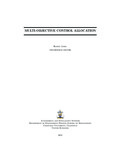JavaScript is disabled for your browser. Some features of this site may not work without it.
| dc.contributor.advisor | Savvaris, Al | |
| dc.contributor.author | Jamil, Ramey | |
| dc.date.accessioned | 2016-10-14T08:19:08Z | |
| dc.date.available | 2016-10-14T08:19:08Z | |
| dc.date.issued | 2012 | |
| dc.identifier.uri | http://dspace.lib.cranfield.ac.uk/handle/1826/10735 | |
| dc.description.abstract | Performance and redundancy requirements imposed on state-of-the-art unmmaned combat aerial vehicles often lead to over-actuated systems with a mix of conventional and novel moment generators. Consequently, control allocation schemes have become a crucial part of the flight control architecture and their design is now a growing problem. This thesis presents a four control allocation scheme designed to meet multiple objectives and resolve objective conflicts by finding the ‘Pareto’ optimal solution, namely; Weighted Control Allocation, Minimax Control Allocation, Canonical Control Allocation and Classical. This is defined as a solution to the multi-objective optimisation problem which is non-dominated for all objectives. The scheme is applied to a six degrees of freedom nonlinear simulation of an aircraft equipped with conventional control surfaces as well as fluidic thrust vectoring and circulation control. The results indicate a perfect allocation of the total control demand onto the actuator suite. | en_UK |
| dc.language.iso | en | en_UK |
| dc.publisher | Cranfield University | en_UK |
| dc.rights | © Cranfield University, 2012. All rights reserved. No part of this publication may be reproduced without the written permission of the copyright holder. | en_UK |
| dc.title | Multi-objective control allocation | en_UK |
| dc.type | Thesis or dissertation | en_UK |
| dc.type.qualificationlevel | Doctoral | en_UK |
| dc.type.qualificationname | PhD | en_UK |
